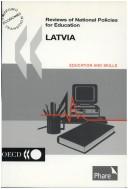| Listing 1 - 2 of 2 |
Sort by
|

ISBN: 1280030909 9786610030903 9264192476 9264186417 9789264192478 Year: 2001 Publisher: Paris : OECD Publishing,
Abstract | Keywords | Export | Availability | Bookmark
 Loading...
Loading...Choose an application
- Reference Manager
- EndNote
- RefWorks (Direct export to RefWorks)
OECD's 2001 review of Latvia's education policies and programmes. It finds that reform of education, training and human resource development is an integral part of the transition to a democratic society and market economy. Latvia has made progress in all these areas since reform began in 1990. The challenge for the Ministry of Education and Science has been to promote and support changes that meet the needs of the new economy and society as well as the interests of all young people and adults, in the face of a shortage of financial and human resources. This book first gives a brief overview of regional issues and a history of education in Latvia and describes the development of education in the country since the political changes. It then presents an analysis of the entire education system and identifies key directions for the reinforcement of the reforms in light of the challenges encountered by officials, communities, enterprises, educators, parents and students under very dynamic conditions. It concludes with a set of key recommendations of goals of education, learning effectiveness, outcomes and the curriculum, management and governance for flexibility, responsiveness and change, and resources and financing.
Education and skills. --- Emerging economies transition. --- Reviews of national policies for education. --- Education and state --- Educational change --- Education --- Education, Special Topics --- Social Sciences --- Change, Educational --- Education change --- Education reform --- Educational reform --- Reform, Education --- School reform --- Education policy --- Educational policy --- State and education --- Government policy --- Educational planning --- Educational innovations --- Social policy --- Endowment of research --- Latvia
Book
Abstract | Keywords | Export | Availability | Bookmark
 Loading...
Loading...Choose an application
- Reference Manager
- EndNote
- RefWorks (Direct export to RefWorks)
The hub-periphery development pattern of the Guangdong economy, to some extent, is a miniature of that of the Chinese economy. The Pearl River Delta, drawing from its first-nature comparative advantages in factor endowments and proximity to Hong Kong SAR, China, and Macau SAR, China, and the second-nature advantages as first-movers in the reforms in attracting and retaining domestic and foreign resources, has developed into a regional economic center. This paper examines the pattern of inter- and intra-provincial migration and that of the concentration of production, to explore the challenges and opportunities for the success of "double transfer." The paper suggests a four-prong approach, to improve the business environment, support the realization of latent comparative advantages, increase the skill level of the labor force to support the upgrade of the production structure, and protect the vulnerable, to support the inclusive growth of the economy in Guangdong in a sustainable manner.
Capital --- Certain extent --- Cheap labour --- Citizens --- Comparative advantages --- Comparative analysis --- Competitiveness --- Credit --- Development --- Development plans --- Development policy --- Development strategy --- Discrimination --- Disposable income --- Economic development --- Economic growth --- Economic integration --- Economic opportunity --- Economic structure --- Economic theories --- Economic theory & research --- Economic welfare --- Economies of scale --- Economy --- Effective policies --- Empirical analysis --- Environment --- Environmental economics & policies --- Equal access --- Equity --- Exploitation --- Exports --- Financial crisis --- Foreign direct investment --- Forestry --- GDP --- GDP per capita --- Gini coefficient --- Government initiatives --- Growth rate --- Health care --- Health services --- Health, nutrition and population --- Immigration --- Incentives --- Income --- Income inequality --- Industrialization --- Intensive industries --- Internal migration --- International migration --- International migration review --- Investment --- Job creation --- Job training --- Labor force --- Labor market --- Labor policies --- Labor productivity --- Labor supply --- Land --- Large cities --- Life expectancy --- Living standards --- Local governments --- Macroeconomics and economic growth --- Market economy --- Migrant --- Migrant workers --- Migration --- Migration data --- Migration flows --- National development --- National level --- National policies --- National population --- Old-age --- Policy --- Policy discussions --- Policy research --- Policy research working paper --- Pollution --- Population --- Population and development --- Population association --- Population census --- Population migration --- Population policies --- Production --- Progress --- Property --- Public goods --- Public services --- Real GDP --- Real wages --- Regional policy --- Relocation of industries --- Resource allocation --- Resources --- Return migration --- Revenue --- Rural areas --- Rural residents --- Sanitation --- Savings deposits --- Skill level --- Skilled workers --- Social protections and labor --- Social science --- Social security --- Social services --- Spatial distribution --- Sustainable access --- Sustainable development --- Taxes --- Temporary migration --- Trade --- Training --- Training opportunities --- Transportation --- Urban areas --- Urban centers --- Urban migration --- Urban population --- Urbanization --- User fees --- Value --- Value added --- Vocational training --- Vulnerable populations --- Wage differentials --- Wages --- Welfare
| Listing 1 - 2 of 2 |
Sort by
|

 Search
Search Feedback
Feedback About UniCat
About UniCat  Help
Help News
News